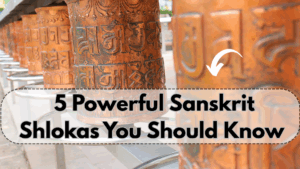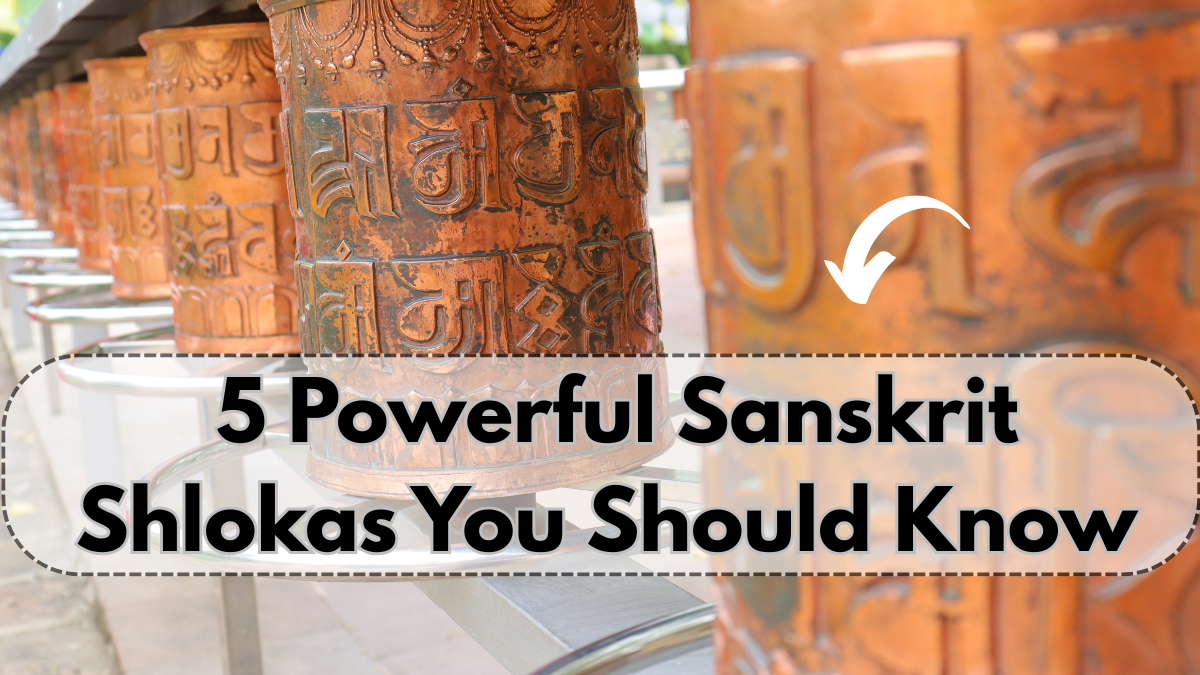Sanskrit shlokas have been cherished for millennia for their spiritual potency and mental clarity. These sacred verses, often from the Bhagavad Gita or Vedic scriptures, carry deep meanings that resonate on a personal and universal level. For devotees and spiritual seekers alike, chanting these shlokas daily cultivates inner strength, focus, and peace.
This guide presents five powerful Sanskrit shlokas with easy-to-understand English meanings, perfect for daily chanting. Integrating these into your routine supports mental clarity and a positive mindset, helping you navigate life with grace and wisdom.

Why Recite Sanskrit Shlokas Daily?
Reciting Sanskrit mantras and shlokas is more than tradition—it’s a form of meditation. The sound vibrations positively affect the mind and body, reducing stress and promoting well-being. Regular chanting helps in:
-
Improving concentration and memory
-
Enhancing spiritual awareness
-
Cultivating calmness and resilience
-
Connecting with divine energy
By making these shlokas a daily practice, you align your thoughts with higher consciousness.
The Five Powerful Sanskrit Shlokas
Below are the 5 most impactful shlokas, complete with their English meanings:
1. Gayatri Mantra
Om Bhur Bhuvaḥ Swaḥ
Tat Savitur Vareñyaṃ
Bhargo Devasya Dhīmahi
Dhiyo Yonaḥ Prachodayāt
Meaning:
We meditate on the divine light of the creator who inspires our intellect and enlightenment.
The Gayatri Mantra is considered the most sacred mantra, invoking universal wisdom and clarity.
2. Maha Mrityunjaya Mantra
Om Tryambakam Yajamahe
Sugandhim Pushtivardhanam
Urvarukamiva Bandhanan
Mrityor Mukshiya Maamritat
Meaning:
We worship the three-eyed Lord Shiva, the fragrant and nourisher. May he liberate us from death and grant immortality.
This mantra is powerful for healing, protection, and longevity.
3. Shanti Mantra
Om Saha Nāvavatu
Saha Nau Bhunaktu
Saha Vīryaṃ Karavāvahai
Tejasvi Nāva Dhītamastu
Mā Vidviṣāvahai
Om Shanti Shanti Shantiḥ
Meaning:
May He protect us together; may He nourish us together. May we work jointly with great energy, may our study be enlightening. May we not dispute with each other. Peace, peace, peace.
Ideal for invoking peace and harmony during study or group activities.
4. Bhagavad Gita Verse 2.47
Karmanye Vadhikaraste
Ma Phaleshu Kadachana
Ma Karma Phala Hetur Bhur
Ma Te Sangostva Akarmani
Meaning:
You have the right to perform your prescribed duties, but you are not entitled to the fruits of actions. Never consider yourself the cause of the results, nor be attached to inaction.
This verse teaches selfless action and detachment from outcomes, a cornerstone of karma yoga.
5. Om Namah Shivaya
Om Namah Shivaya
Meaning:
I bow to Lord Shiva, the supreme reality.
This simple mantra invokes inner strength, peace, and transformation.
How to Incorporate These Shlokas into Daily Life
Start by setting aside a quiet time, ideally morning or evening, for chanting. You can recite each shloka 3-5 times slowly and clearly, focusing on the meaning and sound vibrations.
-
Use a mala (prayer beads) for counting repetitions
-
Maintain a calm and upright posture
-
Breathe deeply and steadily while chanting
Over time, these shlokas will become a natural and grounding part of your spiritual routine.
FAQs
Why are Sanskrit shlokas important?
Sanskrit shlokas carry powerful vibrations that help calm the mind, enhance focus, and connect us to spiritual wisdom.
How often should I chant these shlokas?
Daily chanting is ideal. Even 5-10 minutes per day can bring significant mental and spiritual benefits.
Can beginners chant these shlokas?
Yes, these shlokas are simple and suitable for beginners. Focus on pronunciation and meaning.
What is the benefit of chanting the Gayatri Mantra?
The Gayatri Mantra awakens intellect and brings spiritual illumination.
What is the significance of Om Namah Shivaya?
It is a potent mantra for invoking the energy of transformation and inner peace.
Click here to know more.
